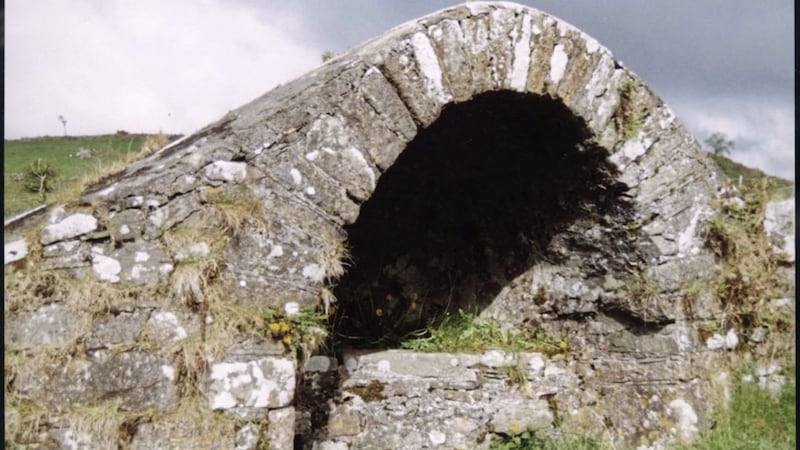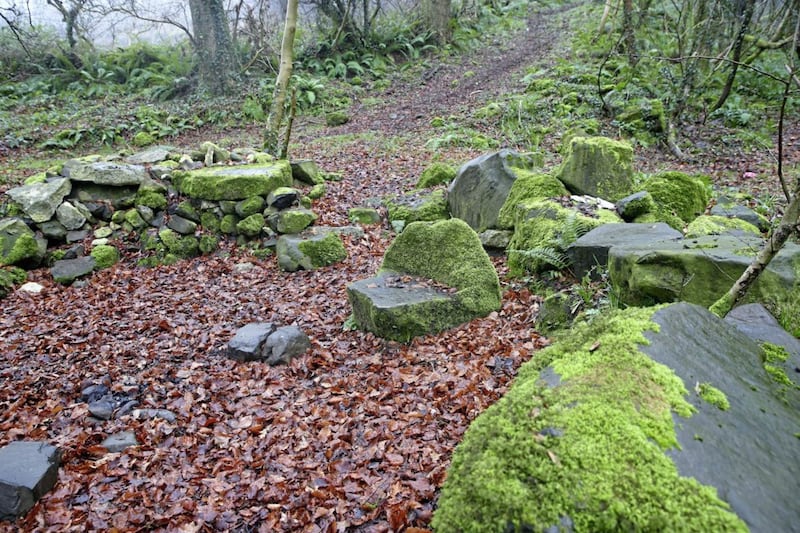AS the 18th century wore on, the severity of the Penal Laws in Ireland lessened.
Where the celebration of Mass became associated with a certain place on a regular basis, some attempt was made to provide a roofing of wood or thatch or other material as a covering for the field altar. Such a covered structure became known as a scáthlán or bothóg.
An example of what one looked like is preserved in Carn graveyard, near Pettigo, where it is built into the side of the churchyard wall. It is protected from the prevailing south-west wind and rain but would provide scant protection against driving snow or a biting east wind.
These primitive early Mass sites eventually evolved into more permanent structures. An example of one such structure can be seen at Tomhaggard in Co Wexford - the only thatched Mass-house of the era extant in Ireland.
William Carleton, writing of conditions in his native Tyrone in the early 19th century, describes how there was always a little plot of green sward attached to the improvised altar.
During the winter months and wet weather in general, the congregation brought with them small trusses of hay or straw on which to kneel to prevent the oozing yellow clay from soiling their clothes.
"During the winter months," he concludes, "the worship of God was in one sense a very trying exercise."
There is a photograph in existence of a congregation attending an open-air Mass at a scáthlán at Bunlin Bridge in Co Donegal about 1867. Despite its late date and the obvious change in dress, the scene depicted would have differed remarkably little from conditions prevailing in the 18th century.
Dr Pococke in his Tour of Ireland in 1752 relates how, on the side of a Donegal mountain, he witnessed several hundred people ranged round a priest who was saying Mass under a rock on an altar made of loose stones, and he goes on to state that in the country for 60 miles west, the people celebrate in the open air, in fields, or in the mountains.
Bishop Plunkett of Meath painted a depressing picture of what conditions were like in his diocese in 1779 and it is unlikely that conditions were any better in Ulster.
He stated that many of the chapels were in wretched condition, inadequately equipped with tattered vestments, torn altar-linen, out-of-date missals and inferior chalices.
Even as late as 1782, when a measure of Catholic emancipation was passed, the use of a bell or steeple was expressly forbidden, and Mass-houses continued to be built in out-of-the-way places. The absence of mention of any kind of baptismal font in any of these chapels would seem to indicate that the sacrament of baptism was conferred in the houses of parents, as indeed were weddings.
The inferior status with which these 'Mass-houses' struggled is reflected in the terms used to describe them. Only the Established Church of Ireland was allowed to use the term 'churches' to refer to their places of worship.
The term 'chapel' was used when referring to Catholic places of worship and the habit became so deeply engrained that Catholics themselves used the term - and indeed occasionally still do, indiscriminately - as do many Protestants.
The 18th century was the heroic century of the Catholic religion in Ireland. Poets and artists have left us their impressions, and the whole era has etched itself deeply on the psyche of the people. W.B. Yeats understood something of the pressures on the priests in Penal times when he wrote:
The old priest Peter Gilligan was weary night and day
For half his flock were in their bed or under green sod lay.
This is the era of the 'soggarth aroon', the dearly loved priest, tending to his flock in the face of fearsome persecution, and celebrating Mass in a secluded glen, whilst lookouts kept watch for the dreaded redcoats.
It is the popular image captured by Felix Kearney when he wrote:
Our priests like wolves were hunted down, O God, 'twas surely hard
That from the right to worship Thee, Thy children were debarred.
But still, they proudly bear Thy Cross, those simple mountain men
Were proud to share Thy Calvary by the Mass-rock in the glen.
The same theme is reiterated by Thomas Collins in his poem, The Mass Rock:
They are coming through the night to the Mass-rock
Their feet are on the stones they know so well
To the church which has no spire to guide their coming
And to call them has no bell.
But the stars are its altar candles
And the night above the glen is all its dome
And they walk as walked the martyrs in their sandals
In the catacombs of Rome.
A final reminder of Penal times is still with us in the form of the Penal Crosses which are to be found in many houses throughout Ireland.
They are usually carved from a single piece of wood, often yew, showing the figure of Christ in high relief, surrounded by the instruments of the Passion, and also featuring a cock and a pot at the foot of the Cross.
The crucifixes are small, normally less than a foot in length and with unusually short cross-arms, so that they could be easily concealed up a sleeve.
Pope John Paul II, on his visit to Ireland in 1979, gave eloquent expression to the importance of the Mass and the different places it has been offered since Christianity first came to our shores some 1,600 years ago. These were his words:
"How many and how varied the places where Mass has been offered - in stately medieval and in splendid modern cathedrals, in early monastic and in modern churches, at Mass-rocks in the glens and forests by hunted priests and in poor thatch-covered chapels for a people poor in worldly goods, but rich in the things of the spirit... For the Irish, it was always the Mass that mattered."
Frank Rogers is the author of The Story of Ireland in Stained Glass and The History of the Convent Chapel, Enniskillen.





